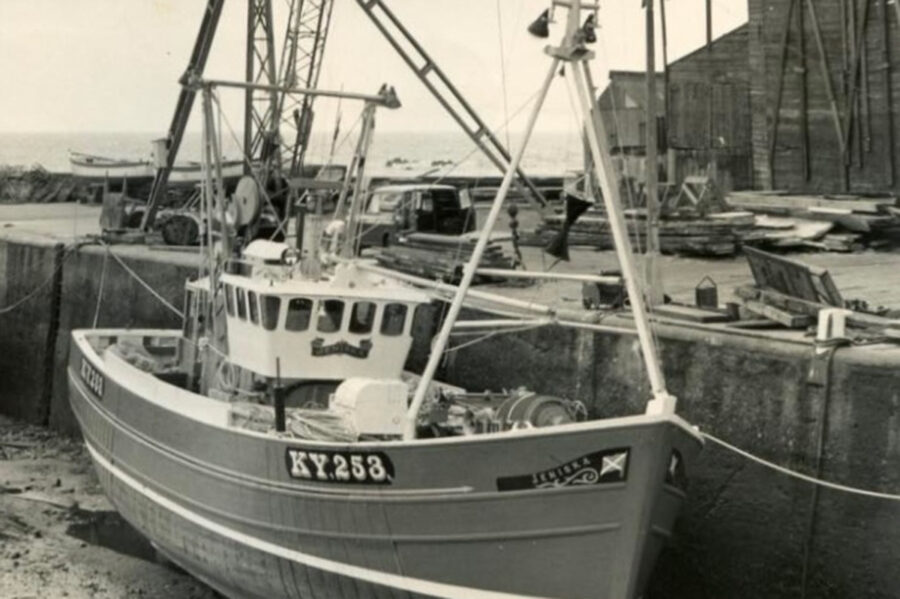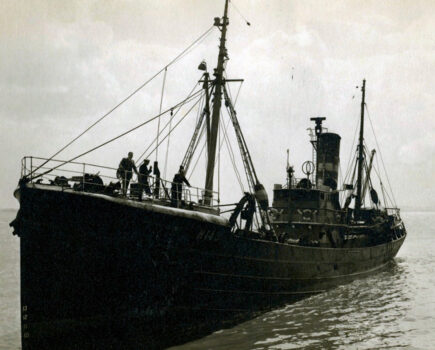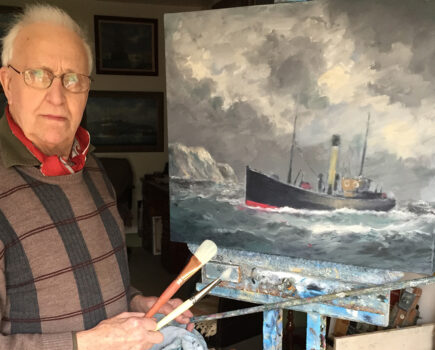Built at the Miller’s yard in St Monans in 1971, Jeniska KY 253 has worked from Fife and Northern Ireland – and is now a fixture of the Campbeltown fleet
By Mike Smylie
It was a still night after the previous day’s gale, the darkness reduced by the lights from the town, a slight smirr damping all around. The boats were in alongside Campbeltown quay, and unloading had begun.
Four boats, each with boxes of prawns sitting on the deck or being hauled up to the waiting hands. I counted: 14 boxes from one looked to be good fishing for the time of year. Another had only seven boxes – somewhat disappointing – and another one 10, which is middle of the road. I missed the fourth!
The four boats – Silver Fern OB 84, Silver Lining III TT 37 (built as Emulate KY 44), Adoration II CN 78 and Jeniska CN 153 are all over 50 years old, with one, Adoration II, being almost 60. All are now working at the prawns, with a chequered history. But it was Jeniska I’d really come to see and here she was, water gently lapping at her old hull as her crew unloaded their catch.
Jeniska was built by JN Miller and Sons of St Monans in 1971 and was commissioned by William H Anderson and John Fleming of Kilrenny in Fife. At 15.66m (56ft) in length, she was fitted with a Gardner 8L3B 229hp. She was one the dual- purpose seiner/trawlers for which Miller’s was renowned, all with the classic transom sterns.
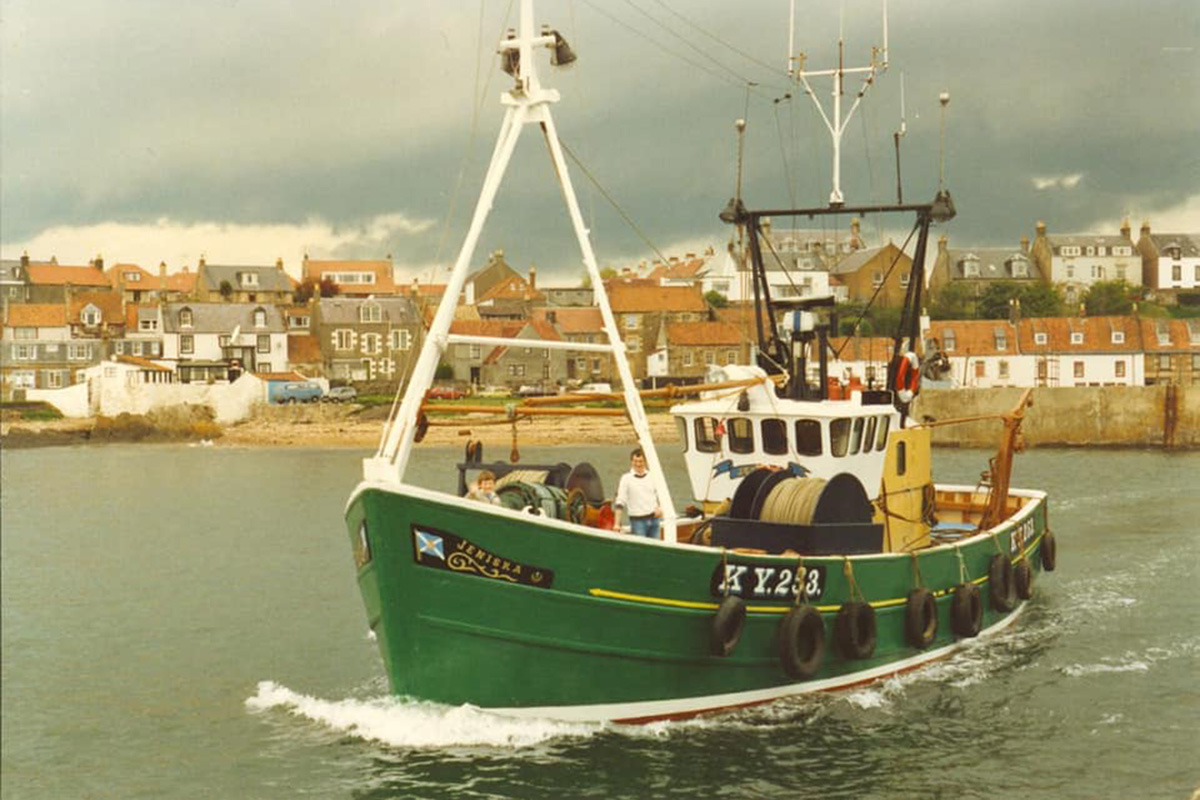
The new vessel steaming out of St Monans.
Brothers Willie and Jimmy Anderson had been fishing with the Ability KY 53, which was the last boat built by Walter Reekie. But when the brothers fell out, they sold her, and Jimmy had the Shanghai-La KY 372 built by Smith and Hutton, whilst Willie had the Jeniska built.
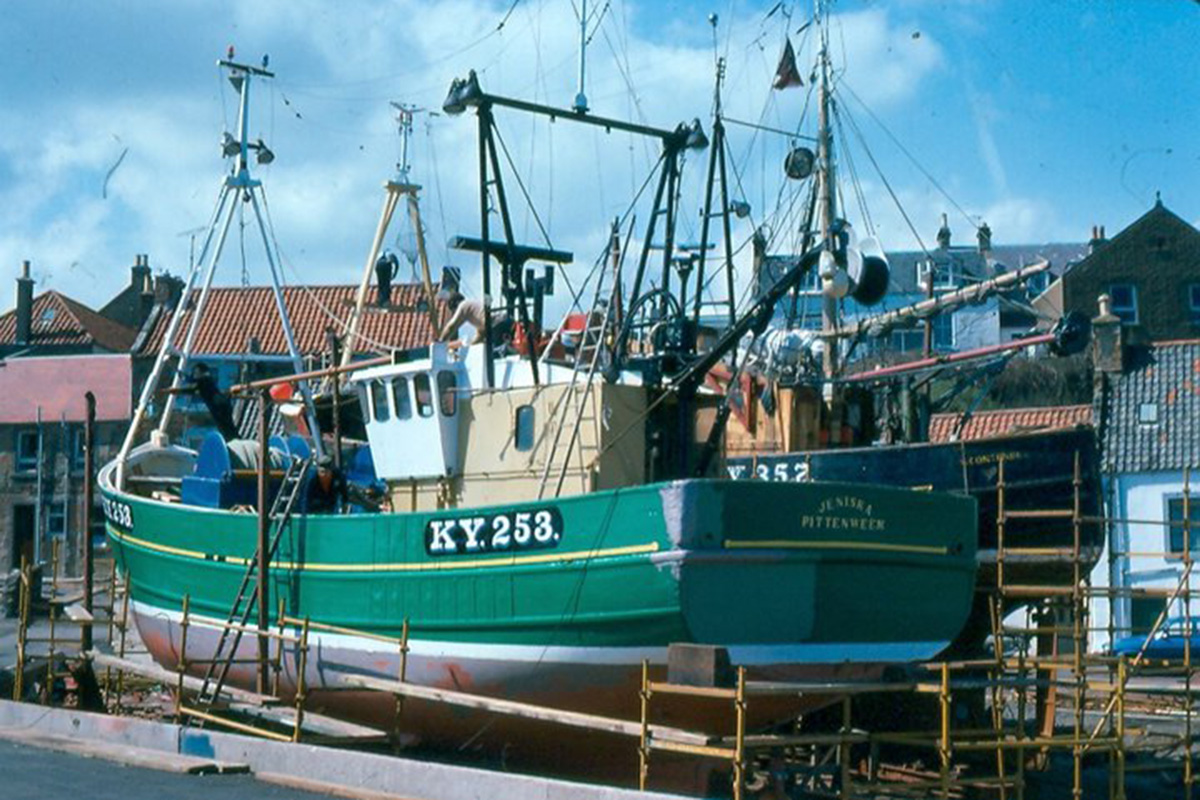
Back up the slip at St Monans in her early days.
Coincidentally, she was built in the same shed in which the old Reekie yard had built the Ability – the No.7 or WestShed–after Miller’s had taken ownership of it subsequent to Walter Reekie’s tragic and untimely death in 1949.
Both brothers decided against having whalebacks on their 55/56ft vessels because of the issue of visibility. Willie, building under the grant scheme of the time, opted to have a gutting machine fitted instead of the whaleback. For Miller’s, this was a new piece of their own-produced equipment, and Jeniska was the first boat to have such a machine fitted onboard. However it wasn’t deemed very successful.
Miller’s yard, first opened in St Monans in 1779, was regarded as one of those producing the best in Scottish wooden fishing craft. Given its two centuries of experience, that’s hardly surprising.
Some say the 1971-built Jeniska came at the time when the yard had reached its peak. In the same year, William Miller retired and emigrated to join family in New Zealand, leaving his nephew and niece James and Jessie in charge of the yard.
Whether he saw the way the industry was going, no one knows, but it is possible he forecast an inevitable end of wooden boats – though the yard, under different management, did later build in steel.
Looking through the Miller’s lists, you realise just how many they were churning out at this time. In 1972, for example, it was seven boats, seven also in 1975 and 1976, and six in 1981 – with four or five in each of the intervening years. Compare that to the others: Jimmy Noble launched five in 1972, Forbes four. For Gerrard’s it was two, and Eyemouth three. On the west coast, Alexander Noble built two.
The days of these fine wooden craft were beginning to come to an end, with only a few years remaining. It was only really the Fraserburgh yards and Miller’s that continued producing wooden vessels into the 1980s. And those were few and far between!
I’ve a full description of the building of Jeniska written by Mike Griffin, who worked upon her during his apprenticeship at Miller’s between February 1968 and February 1972. In it he discusses the various stages.
Miller’s boats were renowned for their very straight stem, of which he says: “The Queen Mary oak stem post was then formed: this was a thing of beauty when complete with its large rounded top tapering down to meet the keel. It then had the apron fitted behind, and this was wider and approx 4in thick to carry the ends of the forward planks and to strengthen the stem assembly. A fore oak knee was fitted atop the deadwood and bolted through the stem and apron to stiffen the whole structure.”
Obviously the stem is one of the strongest parts of any boat, slicing through the water and occasionally coming into contact with unforeseen objects or solid ground! The name comes from the liner of the same name, built in Glasgow, launched in 1934 and commissioned two years later.
Mike Griffin goes on to describe Jeniska’s launch day, with all the preparation in the standing ways, and bracing the launch structure below the vessel, then using heavy wedges and sledgehammers to lift her off the keel blocks to begin the slide into the water.
A good crowd always gathered around the West Shed for a launch, and Jeniska’s was no different. Once the vessel was tied up alongside, the workforce could enjoy a dram or two with the new owner.
Today Jeniska is still remembered as ‘the green boat that visited Fife’. Like many other proud owners of these vessels, Willie Anderson was known for keeping her in immaculate condition throughout her working life with him.
In 1988, she was sold to John Jocky Wood of Pittenweem, renamed Minnie Wood II and re- registered as KY 166. Those that knew him tell me that Jocky was a right character.
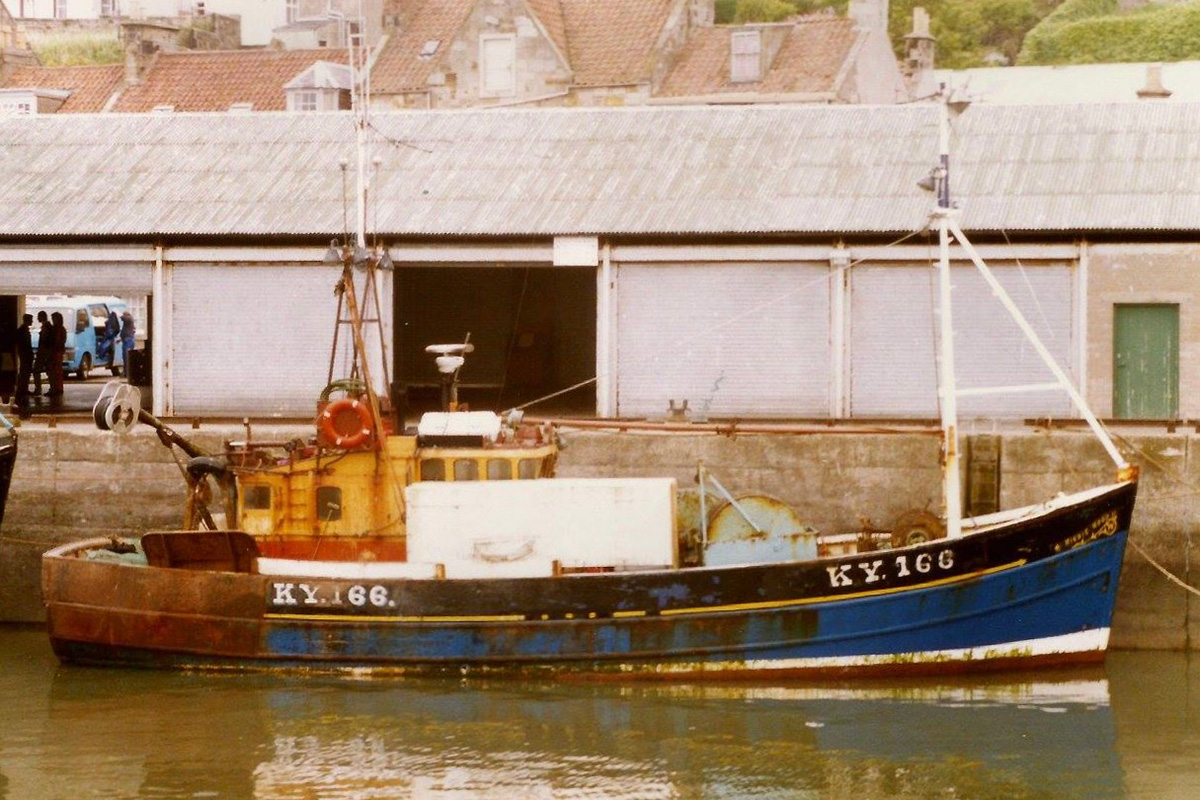
The vessel at Pittenweem after being renamed Minnie Wood II, with the addition of a shelterdeck and a coat of blue paint.
Two years later, the boat was in Northern Ireland, owned by Sean McNabb of Ardglass, at which time she was put back to being Jeniska and re-registered as B 916. At some point the Gardner was taken out and she was re-engined with a Cummins 230hp.

By 1990, the vessel had moved to Northern Ireland and been painted yellow, with a larger deck shelter.
In 2007 she was sold to Eamon Rooney of Ardglass, and then on to Alex Gillies of Campbeltown in 2015, when he re-registered her as CN 153.
“Jeniska, aye, eight years I’ve had her,” Alex told me when I spoke to him at the back end of 2023. “She’s a good wee boat.” He pointed at the Silver Lining III TT 37, which he also owns, sitting in the corner of Campbeltown harbour. “She’s a Miller’s as well – personally I think she’s a better boat than the Jeniska. But the boys like the Jeniska.”

Back to being green, off the southern coast of the Isle of Man.

In Ardglass, showing a stern view
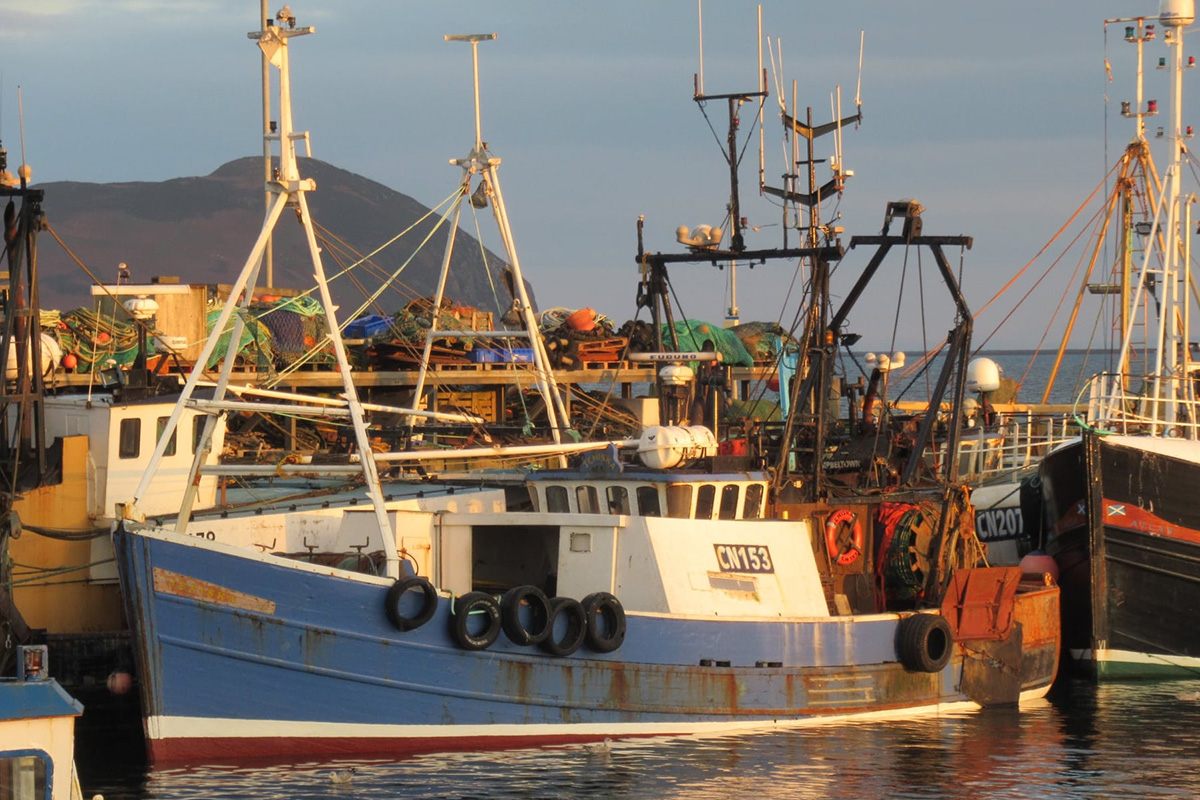
Alongside at Campbeltown.
Perhaps not the best endorsement, and Alex seemed keener to talk about the Silver Lining! But it was Jeniska I wanted to discuss.
“Good sea boat, aye, four crew. Four on each boat, you kind of need that. They had five at the height of the summer.”
Today Jeniska is skippered by Christian Moldovau, who’s been in charge for a couple of years, though has worked for Alex for eight. He knows the boat pretty well, although he had a bit of a scare off Gigha a year or two back, Alex said.
There were five in total onboard the day I was there. All the crew are foreign, as there is the long-running story of a lack of local crew.
“The prices are up this year compared to what they were – but if you go way back to 1978, you got £25 a stone for prawn tails, and it’s only in the last two years that they’ve moved up much from that – they’re maybe up to nearly £40 now,” Alex told me. “But it’s taken a long, long time – there’s no other industry really that’s gone up, what, only 30% in that time.”
Thanks to Mike Griffin and Alex Gillies. See some more images of Jeniska KY 253 below…
This story was taken from the 27 June 2024 issue of Fishing News. For more throwback and nostalgic reports on the UK and Irish commercial fishing sector, subscribe to Fishing News here or buy the latest single issue for just £3.30 here.
Sign up to Fishing News’ FREE e-newsletter here.

